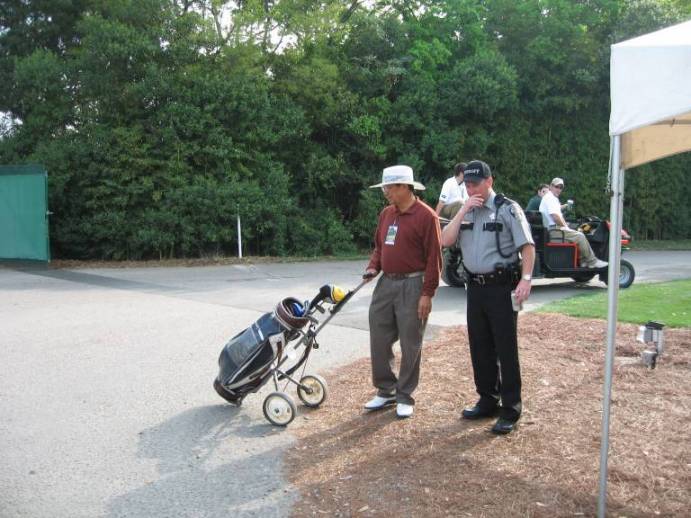DAVIS LOVE III: Well, I think it's taken four or five years for everybody other than players to realize how difficult that golf course is now and what a challenge it is. They've taken the scoring and the fun out of the golf course and made it -- they hate the comparison, they've made it like a U.S. Open rather than a Masters. It's a grinding week. It's a real hilly golf course. It's a tough tournament, plus they've made the golf course extremely hard. So it's a long week. It's been that way for the last five or six really, at least.
Q. Could you talk a little bit about how a lot of people have talked about how Augusta was limited to the big hitters winning the last couple years, but this year it played so firm and fast, some of you guys' balls may have actually been running into trouble and actually could have hurt some of the big hitters a little bit, how it played this year?
DAVIS LOVE III: Well, I don't think it's really ever -- that's always been a big talk. You have to be able to hook it and you have to be able to hit it a long way. Ben Crenshaw has done well there, and the list of guys I just gave, plus Mike Weir. Not necessarily do you have to be a bomber any time. You have to chip and putt well and you have to hit really precise irons to be able to play. Yeah, they've made it long, but we're used to that. Everybody has got length now. It's just a big overreaction to they've perceived that the game has gotten too easy. They want scores to be high.
I think a short game has always been good at Augusta, and Zach proved that, and like I said, Olazábal, Langer, grind it out, chip and putt. It's gotten to be Retief Goosen kind of golf, make a lot of pars and you can win. I certainly wished that I could do that because that's what it takes to win more out here now.
The Greg Norman or Jack Nicklaus style of -- a lot of big, flashy shots and a lot of birdies will win, but that style of golf is tougher to do now. It's got to be more methodical and you've got to chip and putt way better. If I'm teaching my son to play golf, sure, I want him to be long, but you've got to have all the short game shots because they're not going to give you a golf course where you can hit 16 greens a round like they used to. You've got to chip and putt.
If I was a fan, I would be -- I think as a Tour, we can't control the majors, but as a Tour we have to be real careful with our Players Championship and our course setups, that we don't fall into that trap, because most people don't want to watch pros putt for pars on TV. I think we've got to be real careful about that and make sure there's some risk-reward. There's no risk-reward on laying up on 15 every day or laying up on 2 every day or 8. It's just wedging in. Long putts for birdies or short putts for par, I think we have to be real careful about that.
Q. Does that change coming here a little bit? Is it a little bit less demanding?
DAVIS LOVE III: This tournament is more about the weather, really. When it's windy and cold and dry, it plays tough, and when it's wet and calm, you see 13, 14, 15, every once in a while 18-under will win. But if it's really windy and it's really cool, then the scores go way down. We've seen 6-, 7-under win. But that's because it's a good, solid golf course, and it's dictated on the weather.
Here and Colonial seem to get the best reviews from the players because it's all golf course, it's not tricked up. It's a good, solid design, and you can still play. If the weather is bad, the scores go up. That's the thing, at a major now, if the weather is bad they go ridiculous, rather than just from 13-under to 7-under, it goes to average scores of 77s and 78s. And you know if the pros are averaging 77 or 78, the course is probably not fair. It's probably over the edge.
I said to Rich Lerner this morning, what would I shoot at your home course? We go out and shoot 66 every time. On Tour maybe the average should be 68 or 69 or 70, not 77. That just shows you how hard it is.
I mean, even we are astounded at how hard the U.S. Open and The Masters is, so the average person just can't comprehend how hard a golf course it is. I told John Kelly when we got down to 18 on Friday, I said, "Don't worry about this week, this is not real golf. Don't beat yourself up." Because it's not, it's some other game, and it's more a mental test than it is a physical test.
That's why, again, you see guys like Langer and Mize and Mike Weir, guys like that, do well, Retief Goosen, because they're really, really good. But you put them on The International, that format on that golf course, they're not going to do very good with that style of game.
It's nice to have a variety. It seems like the variety has gone out of -- especially out of our three majors over here.















